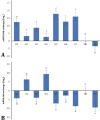Irradiated oocysts in combination with inulin adjuvant-induced potent immune responses against Eimeria tenella infection in broiler chickens
- PMID: 37667788
- PMCID: PMC10475167
- DOI: 10.30466/vrf.2023.563143.3675
Irradiated oocysts in combination with inulin adjuvant-induced potent immune responses against Eimeria tenella infection in broiler chickens
Abstract
Coccidiosis is the leading parasitic disease in poultry. One of the most critical Eimeria species, Eimeria tenella, lives inside the cecal epithelial cells and induces bloody coccidiosis. The present study evaluated the effect of radiation-attenuated E. tenella oocytes mixed with inulin adjuvant on broiler chicken. Initially, the effect of irradiation on oocyst attenuation was confirmed. Then, one-day-old broilers (n = 90) were divided into nine groups on seven days of age as follow: Group 1 (400 attenuated oocysts + 1.00 mg of adjuvant), group 2 (400 attenuated oocysts + 0.50 mg adjuvant), group 3 (200 attenuated oocysts + 1.00 mg of adjuvant), group 4 (200 attenuated oocysts + 0.50 mg adjuvant), group 5 (1.00 mg adjuvant), group 6 (400 attenuated oocysts), group 7 (commercial vaccine), group 8 (negative control) and group 9 (blank). On day 21, we performed a challenge with E. tenella oocytes and investigated oocyst output and average weekly weight throughout the study. At the end of the study, we evaluated macroscopic lesion, histology, cytokine level and leukogram status. The results showed a statistically significant difference among groups. Furthermore, the optimal dose was 400 irradiated oocysts and 1.00 mg of inulin. Moreover, an X-ray could reduce the virulence of E. tenella oocytes. Inulin alone or combined with attenuated oocysts showed an acceptable effect on evaluated parameters.
Keywords: Broiler; Eimeria tenella; Inulin; X-ray.
© 2023 Urmia University. All rights reserved.
Conflict of interest statement
The authors declare that they have no financial or other conflicts of interest that could inappropriately influence this study.
Figures



Similar articles
-
Eimeria tenella oocysts attenuated by low energy electron irradiation (LEEI) induce protection against challenge infection in chickens.Vet Parasitol. 2019 Feb;266:18-26. doi: 10.1016/j.vetpar.2019.01.001. Epub 2019 Jan 6. Vet Parasitol. 2019. PMID: 30736944
-
Evaluation of an experimental irradiated oocyst vaccine to protect broiler chicks against avian coccidiosis.Avian Dis. 2014 Sep;58(3):391-7. doi: 10.1637/10679-092613-Reg.1. Avian Dis. 2014. PMID: 25518433
-
Vaccination with transgenic Eimeria tenella expressing Eimeria maxima AMA1 and IMP1 confers partial protection against high-level E. maxima challenge in a broiler model of coccidiosis.Parasit Vectors. 2020 Jul 10;13(1):343. doi: 10.1186/s13071-020-04210-2. Parasit Vectors. 2020. PMID: 32650837 Free PMC article.
-
Epidemiological aspects of the use of live anticoccidial vaccines for chickens.Int J Parasitol. 1998 Jul;28(7):1089-98. doi: 10.1016/s0020-7519(98)00066-6. Int J Parasitol. 1998. PMID: 9724880 Review.
-
Quantifying the effect of coccidiosis on broiler performance and infection outcomes in the presence and absence of control methods.Poult Sci. 2022 Apr;101(4):101746. doi: 10.1016/j.psj.2022.101746. Epub 2022 Jan 22. Poult Sci. 2022. PMID: 35219136 Free PMC article.
References
-
- Abdisa T, Hasen R, Tagesu T, et al. Poultry coccidiosis and its prevention, control. J Vet Anim Res. 2019;2(1):1–6.
-
- Razmi GR, Kalideri GA. Prevalence of subclinical coccidiosis in broiler-chicken farms in the municipality of Mashhad, Khorasan, Iran. Prev Vet Med. 2000;44(3-4):247–253. - PubMed
-
- Williams RB. A compartmentalised model for the estimation of the cost of coccidiosis to the world’s chicken production industry. Int J Parasitol. 1999;29(8):1209–1229. - PubMed
-
- Georgieva NV, Koinarski V, Gadjeva V. Antioxidant status during the course of Eimeria tenella infection in broiler chickens. Vet J. 2006;172(3):488–492. - PubMed
LinkOut - more resources
Full Text Sources
